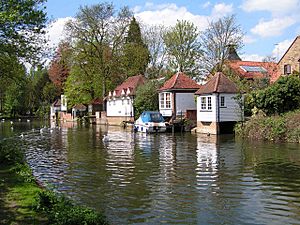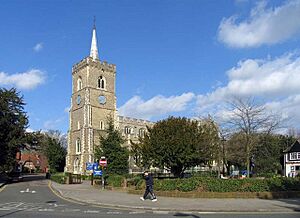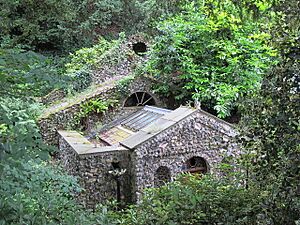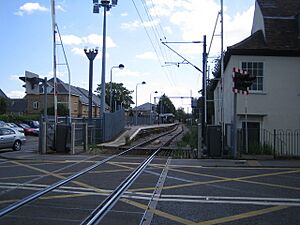Ware, Hertfordshire facts for kids
Quick facts for kids Ware |
|
|---|---|
 Riverside gazebos |
|
| Population | 19,622 (Parish, 2021 Census) |
| OS grid reference | TL 358143 |
| Civil parish |
|
| District |
|
| Shire county | |
| Region | |
| Country | England |
| Sovereign state | United Kingdom |
| Post town | WARE |
| Postcode district | SG12 |
| Dialling code | 01920 |
| Police | Hertfordshire |
| Fire | Hertfordshire |
| Ambulance | East of England |
| EU Parliament | East of England |
| UK Parliament |
|
Ware is a lively town and civil parish in Hertfordshire, England. It's located in the East Hertfordshire area, very close to the county town of Hertford. In 2021, about 19,622 people lived in Ware.
Contents
A Look Back in Time: Ware's History
Archaeological finds show that people have lived in Ware for a very long time, since at least 4000 BC! The Romans also had a big settlement here. They built several buildings, including a temple, and had two cemeteries. Ware was on Ermine Street, an important Roman road that went from London to Lincoln. A well-preserved Roman skeleton of a teenage girl was found near this road and was nicknamed 'Ermintrude'. Some say Ware is one of the oldest places in Europe where people have continuously lived.
In the Domesday Book of 1086, the town was called Waras. This name came from the natural weirs (small dams) in the River Lea. Ware and nearby Hertford have had a friendly rivalry for centuries. In 1090, a noblewoman from Ware changed the Roman road to create a new High Street and bridge over the River Lea. This was a big deal!
Many inns (old hotels) were built along the High Street. This was because Ware was an important stop for coaches traveling on the Old North Road. Even the famous writer Chaucer mentioned Ware twice in his book, The Canterbury Tales. The amazing Great Bed of Ware, which is super big and mentioned by Shakespeare, was kept in different inns in Ware.
During the time of Queen Mary I, a man named Thomas Fust was executed in Ware marketplace for his religious beliefs.
In the 1600s, Ware became the starting point for the New River. This was a special waterway built to bring fresh water to London. In 1647, during the English Civil War, an event called the Ware Mutiny happened. Soldiers were asked to sign a loyalty declaration, and some who refused were arrested. One soldier, Richard Arnold, was shot. After the Great Fire of London in 1666, 62 children were sent to live in Ware. In 1683, there was a plan called the Rye House Plot to assassinate King Charles II near Ware, but it failed.
Ware became a major center for making malt, which is used to brew beer. In 1633, England's first toll road was set up near Ware to help manage the malt traffic. By 1880, Ware had 107 malt kilns, more than any other town in Hertfordshire! The last malting factory closed in 1994. Today, a bronze statue called the Maltmaker stands outside St Mary's Church to remember this important industry.
Two interesting stories from the 1600s are sometimes told. One is that bargemen from Ware didn't have to pay fees on the River Thames because they helped bring food and water to London during the Great Plague of London. The other story says that Ware bargemen brought plague bodies out of London in 1666. However, historical records show that the "Buryfield" was actually a Roman cemetery area, not a place for plague victims.
Towards the end of the 1800s, other industries joined malt-making in Ware. In 1886, Dennis Wickham started a bottling plant that later became an engineering company, making railcars. In 1898, the pharmaceutical company Allen & Hanburys began building a factory in Ware. This company later merged with Glaxo and is now part of GlaxoSmithKline (GSK), which is still a major employer in the town today.
Ware's town council has a special coat of arms that tells its story. The barge rudders on the arms represent the bargemen, and their colors show their connection to London. The crossed coach horns remind us of Ware's history as a coaching town. The barley sheaves represent the town's famous malt-making industry. The motto "cave" (Latin for "beware") is a clever play on the town's name!
Cool Places to See in Ware
Ware has over 200 listed buildings, which means they are historically important. One of these is the remains of a 13th-century friary, which is now the offices for Ware Town Council and a place for events called Ware Priory and Fletcher's Lea.
Right across from the priory is the large St Mary's parish church, built in the 14th century. It's famous for its fancy font (a basin for baptisms) with big carved stone figures. The town is also known for its many 18th-century riverside gazebos, which are small, open buildings, and several have been recently restored.
The Lee Navigation is a canalized river that flows right through the center of Ware. It's a popular spot for visitors and home to many boats.
Ware is also famous for the Great Bed of Ware. This huge bed is mentioned in Shakespeare's play Twelfth Night and is said to be big enough for at least four couples! It's usually kept at the Victoria and Albert Museum in London, but it was on loan to the Ware Museum for a year from 2012 to 2013.
Some buildings on the High Street date back to the 14th century. Ware used to have many coaching inns, and you can still see passageways between some shops that used to lead to their stables. Many of these passages also have old maltings. Crib Street has some beautiful timber-framed buildings that have been restored.
Today, a main employer in Ware is GlaxoSmithKline (GSK), which has large factories and research centers here. The Ware company used to be called Allen & Hanburys, and you can see many historical items about them at the Ware Museum.
Ware Museum
Ware has its own museum, which is run entirely by volunteers! In 2012–2013, the Ware Museum was lucky enough to host the famous Great Bed of Ware on loan from London. Some people even say the bed is haunted by the ghost of its supposed maker, Jonas Fosbrooke!
The museum is partly located in the old Priory Lodge and partly inside a Second World War Command Bunker. This bunker was used to help coordinate local defenses during air raids. The museum has many interesting items from Ware's history, including Roman artifacts, exhibits about World War II, and items from Allen & Hanburys pharmaceuticals. There are also special exhibits for children and fun activity days throughout the year.
Scott's Grotto
Ware is home to Scott's Grotto, a unique place built for John Scott, a poet from the 1700s. This grotto is the largest in the UK! It's a series of chambers that go over 65 feet into a chalk hillside. The chambers are decorated with shells, stones like flint, and colorful glass. The grotto was restored in 1990 and is now managed by the Scott's Grotto Trust. It's a Grade I listed building, meaning it's very important historically.
Bluecoat Yard
In Bluecoat Yard, you'll find Place House, which is Ware's oldest surviving building. It dates back to the early 1300s and was once Ware's Manor House. It has a special type of roof called a crown post roof.
How Ware is Governed
Ware has three levels of local government:
- Ware Town Council (for the town itself)
- East Hertfordshire District Council (for the wider district)
- Hertfordshire County Council (for the whole county)
Historically, Ware was sometimes called a "borough," but it never officially received a special charter from the monarch or sent members to Parliament.
Getting Around Ware
Ware railway station is a stop on the Hertford East Branch Line. Because it's close to London, many people who live in Ware travel to London for work. Trains run twice an hour in both directions between Hertford East and London Liverpool Street.
Bus services connect Ware to other towns like Hatfield, Hertford, Stevenage, and Welwyn Garden City.
The town is located on the main north-south A10 road. There's a large viaduct (a long bridge) over the River Lea at Kings Meads. A bypass road for the A10 opened in 1979, which helped reduce traffic through the town center.
Learning in Ware
Nursery and Primary Schools
As of 2022, Ware and the surrounding villages have fourteen primary schools. There are also many preschools and nurseries for younger children.
Secondary Schools
Ware has two secondary schools: Presdales School and Chauncy School. Presdales School opened in 1906 and is now a comprehensive school for girls aged 11–18 and boys in the sixth form. Chauncy School is for both boys and girls.
Post-Secondary Education
The Creative & Enterprise Campus of Hertford Regional College is also in Ware. A new building opened in 2015, where students can learn about 3D Design, Graphic Design, Fashion Design, Photography, and more.
All Nations Christian College is located nearby and offers training for Christian missionaries.
Fun Things to Do and See in Ware
Sport and Leisure
Wodson Park Sports and Leisure Centre
Wodson Park Sports and Leisure Centre is on the north side of Ware. It's a charity that provides sports and recreation facilities for the community. It has indoor sports halls, restaurants, and an outdoor athletics track. It's also where the Ware Football Clubs play.
Drill Hall
The Ware Drill Hall was built in 1899 and is a Grade II listed building in the center of Ware. It's special because of its early use of a steel curved roof. Today, it hosts sports clubs, community events, and many cultural and music shows.
Cricket
Cricket has been played in Ware since before 1770! The current Ware Cricket Club has its grounds in Widford.
Bowls
The Ware Bowling Club started in 1926 and is located behind Ware Priory. In 2008, it was named Club of the Year by Bowls England.
Football
Ware has two non-League football teams: Ware F.C. (founded in 1892) and Wodson Park F.C. (founded in 1997). Both play their home games at Wodson Park sports center. Ware also has two youth football teams: Ware Lions FC and Ware Youth FC.
American Flag Football
The Ware Wolves flag football team is very popular in Hertfordshire, even though they actually play in Hertford!
Golf
The Chadwell Springs Golf center in Ware was recently renovated in 2019.
Rugby
Hertford Rugby Football Club was formed in 1932. They moved to their current location at Hoe Lane in Ware in 1949. It's also home to the Old Hertfordians Squash Club.
Running
Ware Joggers is a successful running club for all skill levels. They organize annual 10-mile and 10-kilometer races in early July as part of the Ware Festival.
Scouting and Girlguiding
Ware was one of the first places outside of London to start a Scouting movement. Today, it has many Scout and Girlguiding groups.
Swimming
Ware has two swimming pools: one indoors and one outdoors. The Fanshawe Pool and Gym is on Park Road. The Ware Priory Lido was built in 1934. It has a main pool (30m) and a smaller teaching pool, both heated in the summer.
Festivals and Events
Ware Festival and Rock in the Priory
The Ware Festival Committee organizes many events throughout July. These include a fun Carnival Parade, a Raft Race, and a Teddy Bears' Picnic. The festival ends with 'Rock in the Priory', a one-day outdoor music festival. There's always something for everyone during the festival weekends!
Ware Fireworks Display
For over 30 years, Ware has had an annual fireworks display around Guy Fawkes Night. It's now organized by the three Rotary Clubs in Ware. The event is held in a field off High Oak Road and attracts thousands of people. All the money raised goes to local and international charities.
Dickensian Evening
Dickensian Evening is an annual event that celebrates the work of Charles Dickens, especially his Christmas story A Christmas Carol. It takes place on the first Friday in December each year. The town center comes alive with carol singing, fairground rides, and a craft market, making it a fun event for all ages.
Literature
The famous writer Edward Lear mentioned Ware in his book More Nonsense Pictures, Rhymes, Botany, etc: "There was an old person of Ware,
Who rode on the back of a bear:
When they ask'd, - 'Does it trot?'--
He said 'Certainly not!
He's a Moppsikon Floppsikon bear!'"
Media
Ware is covered by BBC London and ITV London for television. You can also receive BBC East and ITV Anglia. Local radio stations include BBC Three Counties Radio and Heart Hertfordshire. The town's local newspaper is the Hertfordshire Mercury.
Religion
The most well-known churches in Ware are St Mary the Virgin, located on the town's high street, and Christ Church.
Twin Towns
Ware is twinned with:
- Cormeilles-en-Parisis, France
- Wülfrath, Germany
Famous People from Ware
- Michael William Balfe (1808–1870), a composer.
- Russ Ballard (born 1945), a musician and composer.
- Charlie Brooks (born 1981), an actress known for EastEnders.
- Richard Chartres, Baron Chartres (born 1947), a retired Bishop of London.
- Sir Richard Fanshawe (1608–1666), a poet and ambassador.
- William Godwin (1756–1836), a philosopher.
- Sir Nigel Hawthorne (1929–2001), a famous actor.
- Minnie Minoprio (born 1942), an actress and singer.
- The Subways (formed in 2002), an English rock band.
- Brian Wilde (1927–2008), an actor known for Last of the Summer Wine.
Sport
- Marc North (1966–2001), a footballer.
- Derek Saunders (1928–2018), a footballer who played for Chelsea F.C..
- Stuart Storey (born 1942), an athlete and sports commentator.
Nearby Communities
See also
 In Spanish: Ware para niños
In Spanish: Ware para niños





